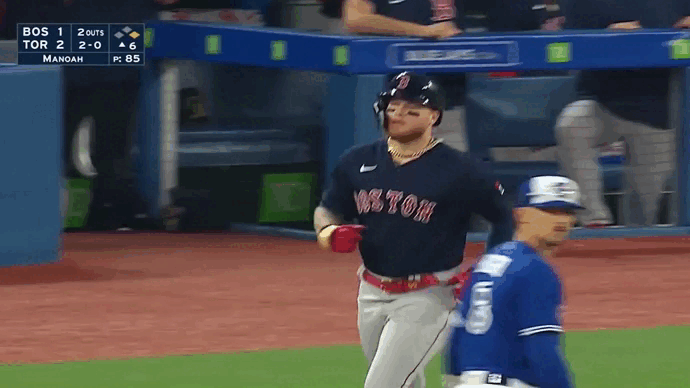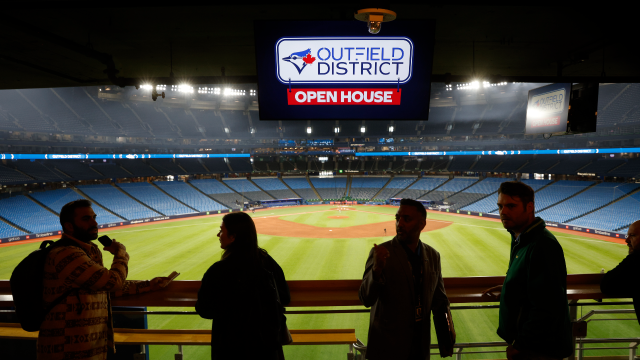
KANSAS CITY — One week into the season, let’s check in on Vladimir Guerrero Jr.:
Strikeouts: 1
Walks: 5
Home runs: 2
Hard-hit balls (95 m.p.h.+): 17, first in MLB
How he’s done it: Laying off whatever’s off the plate, waiting for pitches he can hit, and doing damage. For instance, when Jordan Lyles left a 90 m.p.h. fastball on the inner half Thursday, Guerrero Jr. sent it 436 feet away toward the Kauffman Stadium fountains.
As Blue Jays manager John Schneider recently put it, “Vladdy being Vladdy.”
“Same old Vlad,” said longtime teammate Cavan Biggio. “This year he seems a little more calm and he’s just being himself out there, (letting) things come to him versus at some points he tries to do too much. I think he knows how good he is, and I think he’s just letting the game come to him. I think that’s what he’s going to do for the rest of his career.”
As Biggio notes, Guerrero Jr. doesn’t seem to be feeling too much pressure. He may offer max effort on the bases or while playing first, but at the plate a more composed approach has been working.
“I mean, I feel relaxed these days,” Guerrero Jr. said through interpreter Hector Lebron after hitting his first home run. “I’m the kind of person who believes when you’re trying too hard, when you look for it, it’s going to be harder.”
None of this is new, exactly, but what we’re seeing now calls to mind the 2021 version of Guerrero Jr. — the player who hit 48 home runs, batted .311/.401/.601 and finished second in AL MVP voting. If he’s closer to those levels in 2023, that could push the Blue Jays ahead by a few wins in a closely contested AL East race.
With that, welcome to the second installment of what will be a regular Friday column here this season, and let’s survey some developing storylines with the Blue Jays and beyond:
THE VERDUGO COMMENTS
Players are entitled to their opinions, and the game is better when they speak candidly. At the same time, it’s hard to take what Red Sox outfielder Alex Verdugo says seriously when there’s not consistency between his words and his actions.
First, his words. Speaking to Rob Bradford on the Baseball Isn’t Boring podcast, Verdugo said this about Blue Jays pitcher Alek Manoah:
“If it’s a genuine reaction and it’s for the boys, not directed towards somebody, then yeah (it’s fine),” Verdugo told Bradford. “Like, I’ll say it right now, I think Alek Manoah goes about it the wrong way, 100 per cent I think he does. You can find videos of him, footage of him in triple-A going like this to hitters. Last year, telling Franchy (Cordero) and Bobby (Dalbec) like go sit, (expletive) like that and looking right at them (in July).
“That just pisses me off. It’s not the way it should be played. It should be played like you’re celebrating it with your team, you’re not (expletive) disrespecting another player who is — at the end of the day, we’re just trying to compete, that’s it.”
And now, Verdugo’s actions, from last June after hitting a home run against a familiar face — Alek Manoah of the Blue Jays.
Is Verdugo’s reaction purely for the Red Sox? Or is it possible he’s letting the Blue Jays know he got them? To be fair, there’s nothing wrong with enjoying a home run, and if he wants to let the Blue Jays know it, no one’s stopping him. But there’s nothing wrong with Manoah enjoying a strikeout, either. What’s harder to reconcile is Verdugo having one set of rules for himself and one for everyone else.
SEARCHING FOR MEANING WITH THE RADAR GUN
At this point, it’s a little early to read all that much into radar gun readings. Not only are we talking about small samples here, the Blue Jays just played in cool Kansas City weather, making it harder for the likes of Manoah and fellow starter Kevin Gausman to pitch at full speed.
But according to evaluators tasked with tracking these things, velocity readings do tell a meaningful story within a couple of weeks.
So if lefty Yusei Kikuchi can sustain his boost in velocity for another couple of starts, that would be something to take seriously. On the other hand, if Chris Bassitt’s velocity stays at 91.1 m.p.h., down from 92.9 m.p.h. a year ago, that would also be significant. For now, it’s wait-and-see mode on both.
Sometimes, even the pitchers themselves aren’t sure what to expect. All spring, left-hander Tim Mayza was having trouble finding an extra gear on his sinker. “I felt like I couldn’t ramp up when I needed to,” he recalls. Then in Tuesday’s game against the Royals, the left-hander came in and touched 97 m.p.h. against first baseman Vinnie Pasquantino, the first batter he faced.
“I don’t think I was expecting that by any means, but definitely refreshing and kind of nice to see,” he said. “I just kind of let it loose and wanted to make a quality pitch.”
In 63 appearances last year, Mayza didn’t throw a single pitch that hard. Then, two days later, he topped out at 92.4 m.p.h. All of which to say it’s still early, but these radar-gun readings will tell us meaningful information sooner than we might think.
BUYING SOME TIME
As soon as MLB introduced new rules, you knew teams would look for ways to exploit them. Case in point: if a pitcher asks for a new ball with at least nine seconds remaining on the pitch clock, the clock resets, allowing the pitcher a few more seconds to prepare.
“You started seeing (pitchers) do that pretty deliberately. I think that there’s ways around (the rule), at least to start,” Schneider said. “And then I think probably umpires leave a little note in the locker room for the next guy saying ‘hey, this is what this (pitcher) likes to do.’ … The old ebb and flow of the action and reaction.”
If you’re a pitching coach, you’d want your staff to be aware of this wrinkle for moments they want a little extra time.
LOOKING AHEAD
One under-discussed rule change worth noting as the Blue Jays head to California for the first time this year: MLB quietly discontinued taxi squads for the 2023 season, so the five-player committee of reserves will no longer be available.
Teams can carry one added catcher if they so choose, but otherwise any player with the team must be on the roster or about to join it. At this point, with Daulton Varsho capable of moving behind the plate in an emergency, the Blue Jays aren’t carrying an extra catcher in that capacity.
As such, their 26-man roster is truly that — no extra layer of depth lurking nearby just in case. If the Blue Jays want to make a move, for recently claimed right-handed hitting outfielder Jordan Luplow, say, then they’ll have to do it the old fashioned way by promoting from triple-A.








